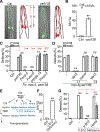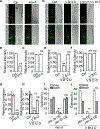Vitamin B12 Regulates Glial Migration and Synapse Formation through Isoform-Specific Control of PTP-3/LAR PRTP Expression
- PMID: 32209461
- PMCID: PMC7281833
- DOI: 10.1016/j.celrep.2020.02.113
Vitamin B12 Regulates Glial Migration and Synapse Formation through Isoform-Specific Control of PTP-3/LAR PRTP Expression
Abstract
Vitamin B12 is known to play critical roles during the development and aging of the brain, and vitamin B12 deficiency has been linked to neurodevelopmental and degenerative disorders. However, the underlying molecular mechanisms of how vitamin B12 affects the development and maintenance of the nervous system are still unclear. Here, we report that vitamin B12 can regulate glial migration and synapse formation through control of isoform-specific expression of PTP-3/LAR PRTP (leukocyte-common antigen-related receptor-type tyrosine-protein phosphatase). We found the uptake of diet-supplied vitamin B12 in the intestine to be critical for the expression of a long isoform of PTP-3 (PTP-3A) in neuronal and glial cells. The expression of PTP-3A cell autonomously regulates glial migration and synapse formation through interaction with an extracellular matrix protein NID-1/nidogen 1. Together, our findings demonstrate that isoform-specific regulation of PTP-3/ LAR PRTP expression is a key molecular mechanism that mediates vitamin-B12-dependent neuronal and glial development.
Keywords: C. elegans; glial development; glial migration; neuronal development; synapse formation; vitamin B12.
Copyright © 2020 The Author(s). Published by Elsevier Inc. All rights reserved.
Conflict of interest statement
Declaration of Interests The authors declare no competing interests.
Figures




Similar articles
-
The two isoforms of the Caenorhabditis elegans leukocyte-common antigen related receptor tyrosine phosphatase PTP-3 function independently in axon guidance and synapse formation.J Neurosci. 2005 Aug 17;25(33):7517-28. doi: 10.1523/JNEUROSCI.2010-05.2005. J Neurosci. 2005. PMID: 16107639 Free PMC article.
-
The Caenorhabditis elegans voltage-gated calcium channel subunits UNC-2 and UNC-36 and the calcium-dependent kinase UNC-43/CaMKII regulate neuromuscular junction morphology.Neural Dev. 2013 May 10;8:10. doi: 10.1186/1749-8104-8-10. Neural Dev. 2013. PMID: 23663262 Free PMC article.
-
Unbiased identification of substrates of protein tyrosine phosphatase ptp-3 in C. elegans.Mol Oncol. 2016 Jun;10(6):910-20. doi: 10.1016/j.molonc.2016.03.003. Epub 2016 Mar 25. Mol Oncol. 2016. PMID: 27067626 Free PMC article.
-
Emergent Synapse Organizers: LAR-RPTPs and Their Companions.Int Rev Cell Mol Biol. 2016;324:39-65. doi: 10.1016/bs.ircmb.2016.01.002. Epub 2016 Feb 8. Int Rev Cell Mol Biol. 2016. PMID: 27017006 Review.
-
LAR-RPTPs: synaptic adhesion molecules that shape synapse development.Trends Cell Biol. 2013 Oct;23(10):465-75. doi: 10.1016/j.tcb.2013.07.004. Epub 2013 Aug 3. Trends Cell Biol. 2013. PMID: 23916315 Review.
Cited by
-
Newly Identified Deficiencies in the Multiple Sclerosis Central Nervous System and Their Impact on the Remyelination Failure.Biomedicines. 2022 Mar 30;10(4):815. doi: 10.3390/biomedicines10040815. Biomedicines. 2022. PMID: 35453565 Free PMC article. Review.
-
Adaptive capacity to dietary Vitamin B12 levels is maintained by a gene-diet interaction that ensures optimal life span.Aging Cell. 2022 Jan;21(1):e13518. doi: 10.1111/acel.13518. Epub 2021 Dec 8. Aging Cell. 2022. PMID: 35032420 Free PMC article.
-
A mixed antioxidant supplement improves cognitive function, and coordination in aged mice.J Clin Biochem Nutr. 2024 Mar;74(2):119-126. doi: 10.3164/jcbn.23-71. Epub 2023 Oct 12. J Clin Biochem Nutr. 2024. PMID: 38510681 Free PMC article.
-
Glia Development and Function in the Nematode Caenorhabditis elegans.Cold Spring Harb Perspect Biol. 2024 Dec 2;16(12):a041346. doi: 10.1101/cshperspect.a041346. Cold Spring Harb Perspect Biol. 2024. PMID: 38565269 Free PMC article. Review.
-
Importance of Bioactive Substances in Sheep's Milk in Human Health.Int J Mol Sci. 2021 Apr 22;22(9):4364. doi: 10.3390/ijms22094364. Int J Mol Sci. 2021. PMID: 33921992 Free PMC article. Review.
References
-
- Ackley BD, Harrington RJ, Hudson ML, Williams L, Kenyon CJ, Chisholm AD, and Jin Y (2005). The two isoforms of the Caenorhabditis elegans leukocyte-common antigen related receptor tyrosine phosphatase PTP-3 function independently in axon guidance and synapse formation. J. Neurosci 25, 7517–7528. - PMC - PubMed
-
- Ahuja R, Yammani R, Bauer JA, Kalra S, Seetharam S, and Seetharam B (2008). Interactions of cubilin with megalin and the product of the amnion-less gene (AMN): effect on its stability. Biochem. J 410, 301–308. - PubMed
-
- Barres BA (2008). The mystery and magic of glia: a perspective on their roles in health and disease. Neuron 60, 430–440. - PubMed
Publication types
MeSH terms
Substances
Grants and funding
LinkOut - more resources
Full Text Sources
Research Materials
Miscellaneous

